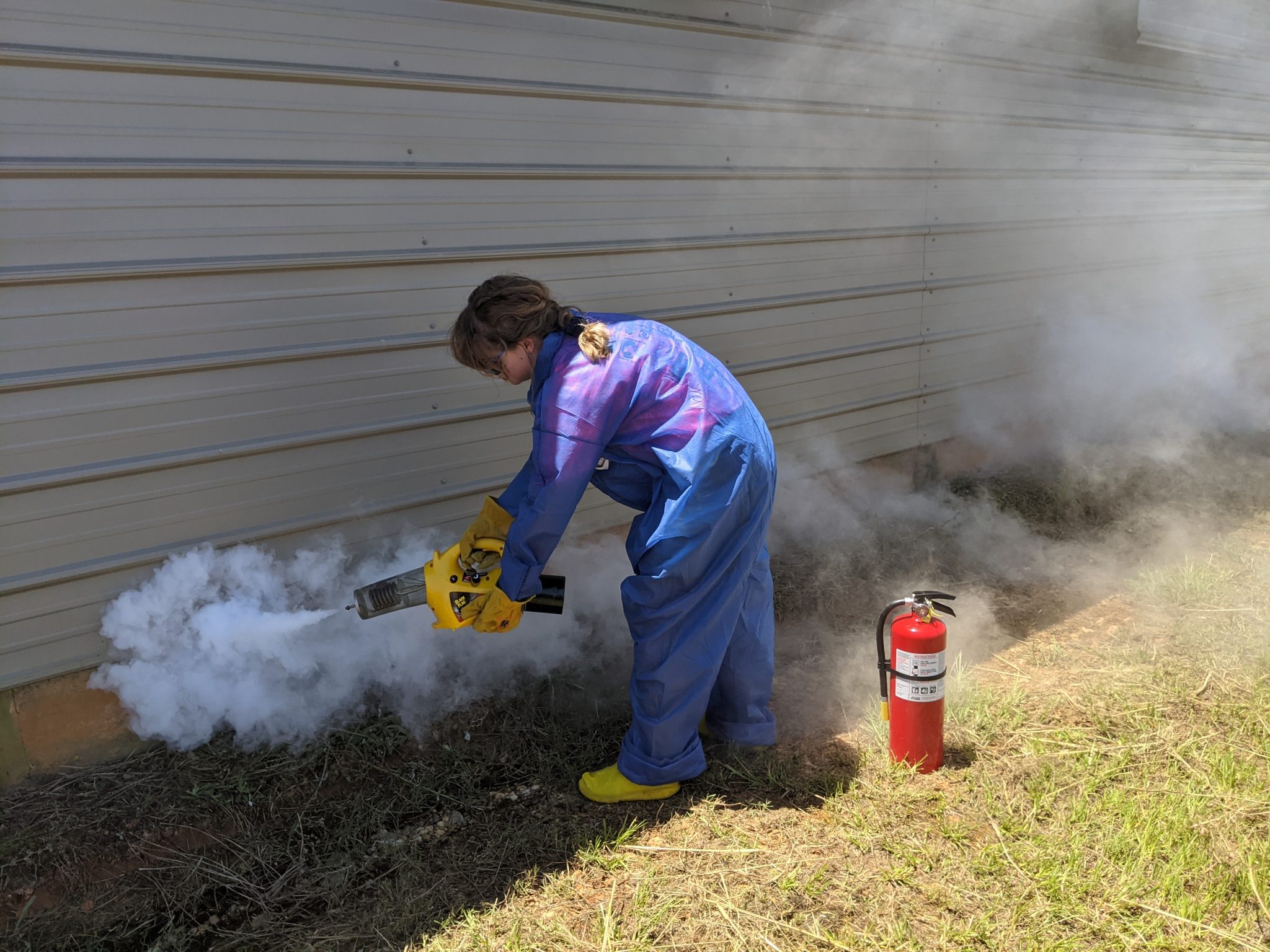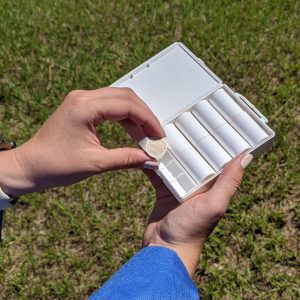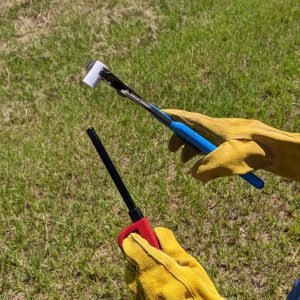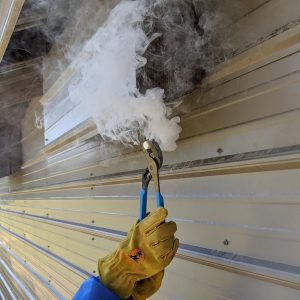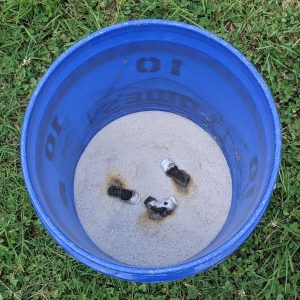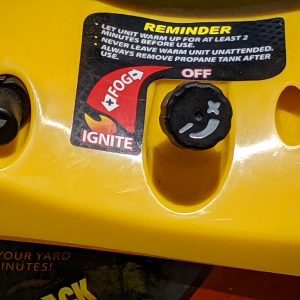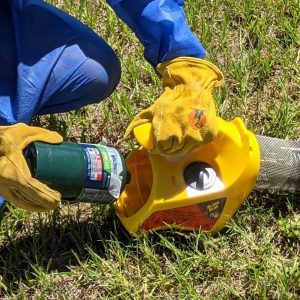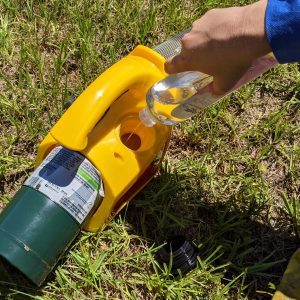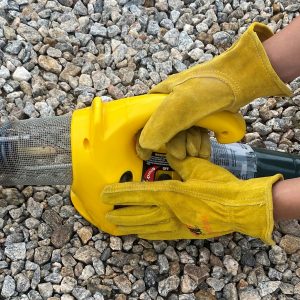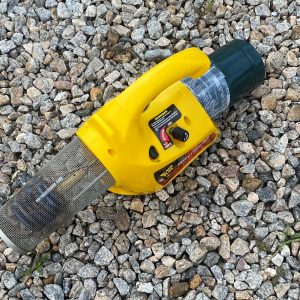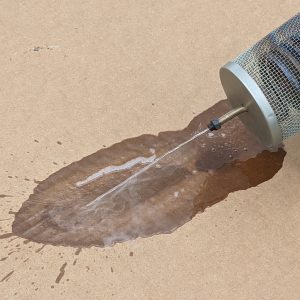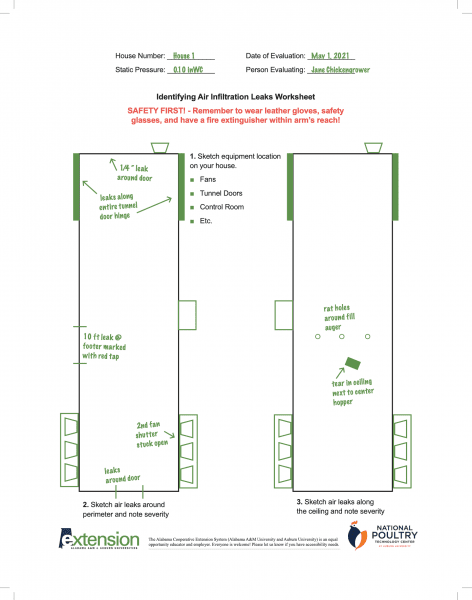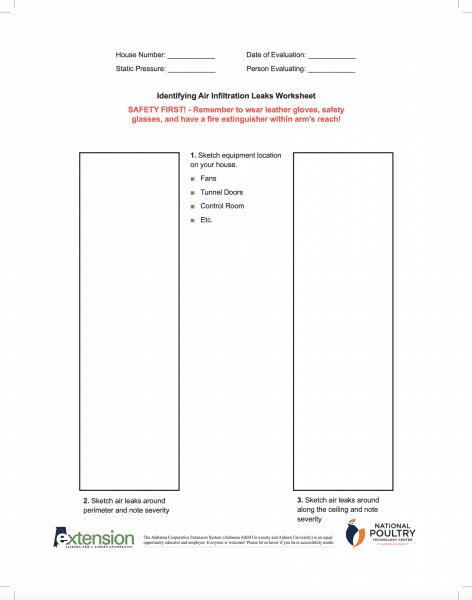Farming

The most effective way to find air leaks in your poultry houses is to visualize it by using smoke emitters or an insect fogger.
Smoke emitters and insect foggers can be used to test commercial poultry houses for air infiltration leaks. Monitoring how much air is entering your houses through planned air openings during the summer and winter flocks is important. Learn to detect where any unplanned air is entering the structure through curtains, doors, or other areas of the building.
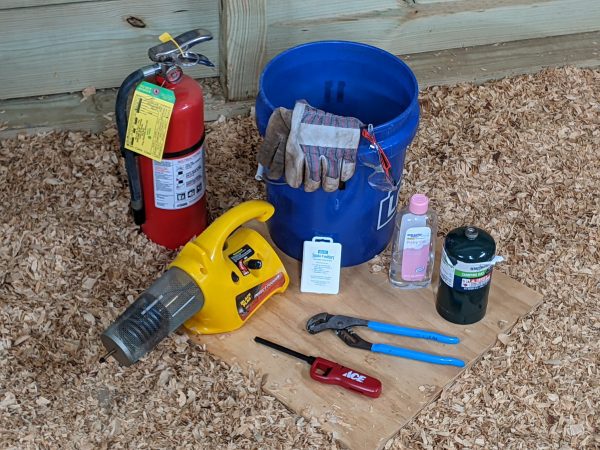
Figure 1. Tools to perform a smoke test: insect fogger, lighter, channel locks, smoke emitters, oil, propane cylinder, safety glasses, leather gloves, fire extinguisher, and bucket of dirt or sand.
Before you begin identifying air leaks, you need to gather the necessary tools to perform a smoke tracing test (figure 1).
- Personal protective equipment (PPE) such as safety glasses, an N95 mask, and leather gloves to protect your hands
- Fire extinguisher as a safety backup in case of a fire
- Smoke Emitter Method
- Bucket of dirt or sand to throw the used smoke emitters into
- Smoke emitters (smoke bombs, such as REGIN S103, 90-second smoke emitters) to visually trace air flow
- Utility lighter or minitorch to light the smoke emitters
- Pliers (channel lock, vice-grip, or equivalent) to safely hold the smoke emitters
- Insect Fogger Method
- Insect fogger to generate smoke to visually trace air flow
- Oil (baby oil, mineral oil, etc.) to be used with the fogger
- 16-ounce propane fuel cylinder (camping gas) to power the fogger
Steps to Light and Use Smoke Emitters (Smoke Bombs)
1. Before performing a smoke tracing test, the house must be under negative pressure. See “Identifying and Marking Air Infiltration Leaks” below.
2. Put on a pair of leather gloves, safety glasses, and an N95 mask if you have breathing issues. Have a fire extinguisher within arm’s reach.
3. Take out one 90-second smoke emitter (figure 2) and then close and set the package aside.
4. While securely holding the smoke emitter with pliers away from your body, light it by inverting the open end over the flame of a lighter or torch (figure 3). You may need to block the wind while lighting the emitter. Never light the smoke emitter near flammable objects, such as clothing or sidewall curtains.
5. Once lit, hold the smoke emitter near the area where you want to test for air leaks (figure 4). Slowly move the emitter along the outside of the house. It will take multiple emitters to evaluate a commercial broiler house.
6. Once the smoke emitter is dead, drop it in a bucket of wet dirt or sand (figure 5). The smoke emitter will still be hot to the touch and can melt the bottom of a plastic bucket.
- Figure 2. Removing a single 90-second smoke emitter (S103, REGIN) from the box.
- Figure 3. Hold the smoke emitter upside down in one hand with a pair of pliers while lighting it with a torch.
- Figure 4. Slowly move the smoke emitter along the outside of the house.
- Figure 5. Drop spent smoke emitters into a bucket of sand to prevent a fire hazard.
Steps to Light and Use Insect Foggers
1. Before performing a smoke tracing test, the house must be under negative pressure. See “Identifying and Marking Air Infiltration Leaks” below.
2. Put on a pair of leather gloves, safety glasses, and an N95 mask if you have breathing issues. Have a fire extinguisher within arm’s reach.
3. Before connecting the propane tank to the insect fogger, remove any dust or debris on the propane connection of the fogger, and make sure the ignition knob on the fogger is turned completely off (figure. 6). Secure the propane tank to the fogger according to the manufacturer’s recommended instructions.
4. Remove the oil tank fill cap and fill the fogger with a manufacturer-approved oil, such as baby oil (figure 7).
- Figure 6a. Turn the ignition knob to the off position.
- Figure 6b. Connect the propane tank to the fogger.
- Figure 7. Adding oil to the insect fogger.
5. While holding the insect fogger on the ground, turn the ignition knob to the open position and push the auto-ignite button until the fogger lights (figure 8). It can be hard to see the flames so be sure to keep all flammable surfaces like clothing, biosecurity suits, dry bedding, and dry grass away from the mesh burner.
6. Once lit, allow sufficient time for the fogger to pre- heat (figure 9). Failure to preheat can result in poor fog quality and cause the fogger to spit hot oil on
the ground. If this happens, place the fogger on a nonflammable surface and allow extra time to heat. Hot oil can cause burns to skin and clothing and is a potential fire hazard if in contact with flammable materials such as dry grass.
7. Once quality fog is produced, hold the insect fogger near an area where you want to test for air leaks (figure 10). Keep a fire extinguisher within arm’s reach.
8. Push the trigger every 3 or 4 seconds to emit the smoke. Note: if liquid is dripping from the nozzle, slow down your pumping speed (figure 11).
- Figure 8. Turn the ignition knob to the open position and push the auto-ignite button until the fogger lights. Keep all body parts and flammable material away from the mesh burner.
- Figure 9. Let the fogger preheat on the ground or other nonflammable surface and away from flammable materials until the fogger produces good fog quality when the trigger is pulled.
- Figure 10. Activate the fogger near an area of interest on the outside of the house.
- Figure 11. Oil dripping from the nozzle means you may need to let the fogger preheat longer or you may need to slow down your pumping speed. Cardboard in this figure is for illustration purposes only. Make sure you light the fogger on the ground away from flammable materials.
Identifying and Marking Air Infiltration Leaks
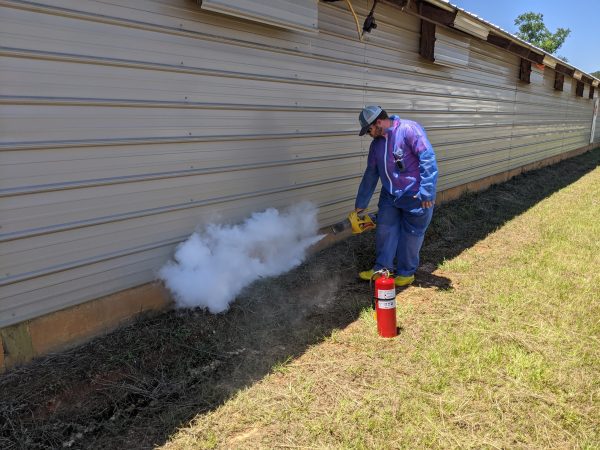
Figure 12. Have a partner smoke the outside of the house along the perimeter.
1. Notify everyone on your farm and any close neighbors that you will be performing a smoke test to prevent unnecessary calls to the fire department.
2. Close up your house (tunnel doors, sidewall inlets, and attic inlets) and turn on enough fans to create a negative pressure. A static pressure of 0.10 inches of water column or greater would be good.
3. Have a partner (with leather gloves and safety glasses) stand outside the house with a smoke emitter or insect fogger. Keep a fire extinguisher within arm’s reach.
4. Beginning at one location, have your partner move close to (but not touching) areas of interest with the smoke emitter or insect fogger on the outside of the house (figure 12). You should move on the inside of the house and identify areas where smoke is entering the structure.
5. Mark locations where smoke enters the house using something bright and easy to see: chalk, flagging tape, or white or neon spray paint. Here we are using red tape to identify a large air leak at the base of a tunnel door (figure. 13). A two-way radio is helpful with communication.
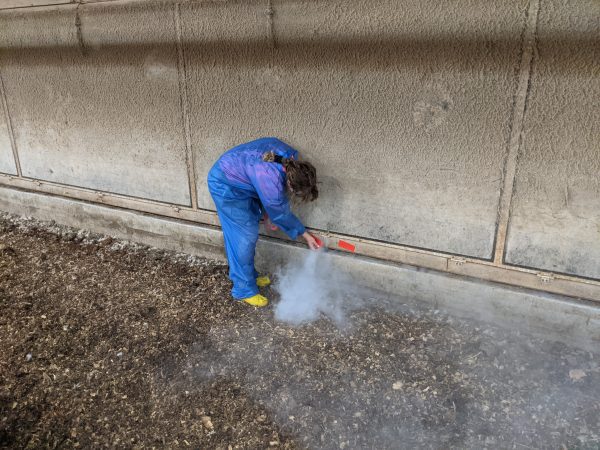
Figure 13. Mark all locations where smoke enters the house perimeter with something bright and easy to see: marking tape, spray paint, etc. Here we are using red tape to identify a large leak at the base of the tunnel door.
6. Use the Identifying Air Infiltration Leaks Worksheet to document the house number, static pressure, date of evaluation, and person evaluating the house for air leaks. Mark the location and severity of any air leaks on the worksheet. Keep these worksheets as a record to track air leaks that need to be fixed or new air leaks that are found between air infiltration inspections.
7. Before leaving each house and farm, scan the premises to verify that all smoke emitters are accounted for and in the bucket. Be sure that there are no potential fire hazards left behind.
Safety Warnings
- Always wear personal protective equipment (PPE).
- Abstain from performing this activity if you have trouble breathing in conditions related to smoke. Wear an N95 mask to prevent smoke inhalation.
- Use a pair of pliers, or nonflammable device to prevent burns. Smoke emitters get hot.
- Use extreme caution because smoke tracing is a fire hazard. Keep a fire extinguisher within arm’s reach and know how to properly use it.
- Always read the insect fogger user manual and follow technical and safety instructions when performing smoke tracing activities.

 Amanda Burgett, National Poultry Technology Center (NPTC) Undergraduate Research and Extension Intern; Jeremiah Davis, Extension Specialist, Associate Professor, Director, NPTC; Jesse Campbell, Extension Specialist, Assistant Extension Professor, NPTC; Joseph Purswell, Research Leader, USDA ARS Poultry Research Unit; Kelly Griggs, Research Engineer, NPTC; Cody Smith, Research Engineer, NPTC; Martha Sabine Rueda Lastres, Graduate Research Assistant, NPTC; and Carson Edge, Graduate Research Assistant, NPTC
Amanda Burgett, National Poultry Technology Center (NPTC) Undergraduate Research and Extension Intern; Jeremiah Davis, Extension Specialist, Associate Professor, Director, NPTC; Jesse Campbell, Extension Specialist, Assistant Extension Professor, NPTC; Joseph Purswell, Research Leader, USDA ARS Poultry Research Unit; Kelly Griggs, Research Engineer, NPTC; Cody Smith, Research Engineer, NPTC; Martha Sabine Rueda Lastres, Graduate Research Assistant, NPTC; and Carson Edge, Graduate Research Assistant, NPTC
The authors would like to thank fellow students Juliana Rezek, Baylor Arnold, Abigail Lane, Drew Johnson, and Leah Smith for their assistance in this effort as part of the 2021 NPTC Research and Extension Experience for Undergraduates (NPTC REEU) Program.
New August 2021, NPTC Tools of the Trade: Smoke Tracing to Identify Air Infiltration Leaks, ANR-2822

